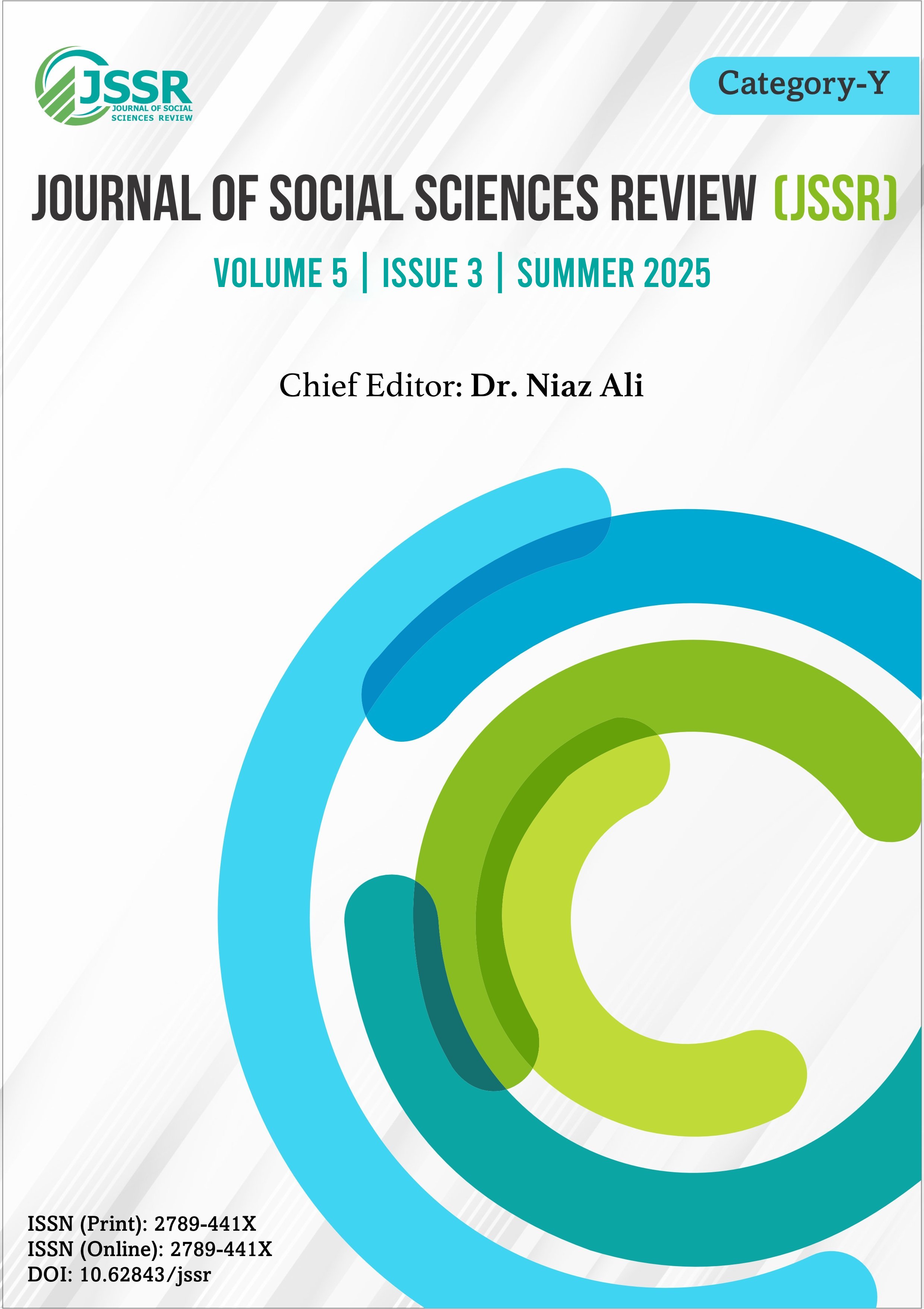The The Dark Side of Matriarchy: Control, Repression, and Tragedy in The House of Bernarda Alba: A Psychoanalytical Study of Motherhood in Lorca's Rural Spain
DOI:
https://doi.org/10.62843/jssr.v5i3.563Keywords:
Matriarchy, Repression, Female Authority, TragedyAbstract
This study examines Lorca's portrayal of motherhood and rural household as an epitome of matriarchal control, a suffocating household and the contagious nature of oppression within a family structure. The central character, Bernarda, exudes the image of hierarchical power which engulfs the freedom of her own daughters in the house, notwithstanding her mother and servants. This attitude of hers brings the family to a tragically heightened stage where the youngest commits suicide and the elder ones live like the dead. This research accentuates the nature of power in both ways; as an active force in the form of Bernarda's dictatorial behavior and as a passive force that has overcast the whole house making the girls no more than puppets in the hands of their irrational despotic mother. Drawing on Jungian theory, this research argues matriarchy can be destructive when rooted in patriarchal values, harming women themselves. The paper does not limit the study to the text of the play as a specimen of the destructive nature of the mother figure, but also includes the feminist strains, cultural implications and the behavioural and psychological patterns of certain characters in specific situations in order to highlight and elaborate on the selected character of Bernarda Alba from multiple critical viewpoints. The paper provides an extensive study of Bernarda Alba's character and household not only as the darker side of the mother figure and female destructive powers but also the household as a politically charged sphere of power, control and repression which ultimately brings forth the tragic confrontations and Adeila's suicide.
References
Aeschylus. (1900). The Oresteia of Aeschylus (G. C. W. Warr, Trans.). George Allen.
Allegory Explained. The House of Bernarda Alba. https://allegoryexplained.com/the-house-of-bernarda-alba/
Allen, R. C. (1991). Psyche and symbol in the theater of Federico García Lorca. University of Texas Press. https://www.jstor.org/stable/10.7560/764187
Behroozfar, L. (2010). A Foucauldian reading of The House of Bernarda Alba. Academia.edu. https://www.academia.edu/394303/A_Foucauldian_Reading_of_The_House_of_Bernarda_Alba
Butler, J. (1990). Gender trouble: Feminism and the subversion of identity. Routledge.
Davies, P. (2015). Matriarchy/Patriarchy. In R. Segal, & K. von Stuckrad (Eds.), Vocabulary for the Study of Religion (1 ed.). Brill Academic Publishers.
Delgado, M. M. (2008). Federico García Lorca. Routledge.
Stanton, E. F., & Edwards, G. (1981). Lorca: The theatre beneath the sand. World Literature Today, 55(3), 439. https://doi.org/10.2307/40136595
Gilbert, S. M., & Gubar, S. (1979). The madwoman in the attic: The woman writer and the nineteenth-century literary imagination. Yale University Press. https://doi.org/10.2307/j.ctvxkn74x
Goettner-Abendroth, H. (2012). Matriarchal societies: Studies on indigenous cultures across the globe (P. Lang, Ed.). Peter Lang Publishing.
Havard, R. G. (1985). The hidden parts of Bernarda Alba. Romance Notes, 26(2), 102–108. https://www.jstor.org/stable/43800793
Ibsen, H. (1891). Hedda Gabler. In E. Seaman (Trans.), Hedda Gabler and Other Plays (p. 1–96).
Jung, C. G. (1991). The archetypes and the collective unconscious (R. F. C. Hull, Trans.; 2nd ed.). Routledge.
Larson, C. (1997). Women and madness in Iberian literature. In Echoes of madness (pp. 45–67). Bucknell University Press.
Lorca, F. G. (1936). The house of Bernarda Alba (M. Dewell & C. Zapata, Trans.). Farrar, Straus and Giroux.
Morpeth, R., & Langton, P. (1974). Contemporary matriarchies: women alone: independent orincomplete? The Cambridge Journal of Anthropology, 1(3), 20–38. http://www.jstor.org/stable/45259115
Poeta, S. J. (1999). Poetic and Social Patterns of Symmetry and Contrast in Lorca’s La casa de Bernarda Alba. Hispania, 82(4), 740–749. https://doi.org/10.2307/346339
Polydorou, E. M. (2011). The reception of Federico Garcia Lorca and his rural trilogy in the UK and Spain after 1975 . University of Birmingham.
Rich, A. (1976). Of woman born: Motherhood as experience and institution. Norton.
Ryan, L. (2011). Memory and modernity in democratic Spain: The difficulty of coming to terms with the Spanish Civil War. Lexington Books.
Taylor, D. (1991). Theatre of crisis: Drama and politics in Latin America. University Press of Kentucky. https://core.ac.uk/download/pdf/232566187.pdf
The Fitzwilliam Museum. (2025). The story of Demeter and Persephone. https://fitzmuseum.cam.ac.uk/
Willey, A. (2016). Undoing monogamy: The politics of science and the possibilities of biology. Duke University Press. https://doi.org/10.2307/j.ctv1134cs6
Downloads
Published
Issue
Section
License
Copyright (c) 2025 Copyright in the Journal of Social Sciences Review is retained by the author(s). Authors also grant any third party the right to use the article freely as long as its integrity is maintained and its original authors, citation details and publisher are identified.

This work is licensed under a Creative Commons Attribution-NonCommercial 4.0 International License.
SSR's Editorial Board shares the vision of providing free access to information, education, and science for everyone, thus promoting its content through an OPEN ACCESS POLICY, fulfilling the DOAJ definition of open access. The JSSR adheres to an Open Access and Copyright Licensing Policy based on the belief that making research freely accessible to the public promotes greater global knowledge sharing.
The JSSR uses the Creative Commons Attribution-NonCommercial 4.0 International License. The authors who apply and publish in JSSR consent to abide by the copyright policy set out in the Creative Commons 4.0 license (Attribution-NonCommercial 4.0 International license).
- Copyright in the Journal of Social Sciences Review is retained by the author(s).
- Authors also grant any third party the right to use the article freely as long as its integrity is maintained and its original authors, citation details and publisher are identified.
While "By 'open access' to this literature, we mean its free availability on the public internet, permitting any users to read, download, copy, distribute, print, search, or link to the full texts of these articles, crawl them for indexing, pass them as data to software, or use them for any other lawful purpose, without financial, legal, or technical barriers other than those inseparable from gaining access to the internet itself."



